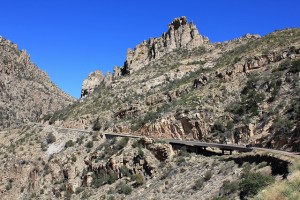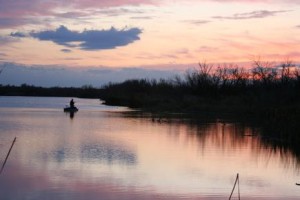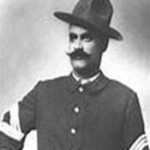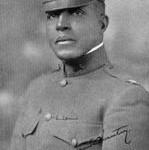
Climbing more than 6,000 feet,the Sky Island Scenic Byway begins with forests of saguaro cacti in the Sonoran Desert and ends in a cool, coniferous forest on the Santa Catalina Mountains. Prepare yourself for breathtaking views and a climate change that would be similar to driving from Southern Arizona to Northern Montana. Each thousand feet up is like driving 600 miles north offering a unique opportunity to experience 4 seasons in one trip.
The scenic drive begins at the outside edge of Tucson. If you are coming from I-10, take exit 256 and follow East Grant Road for 8 miles. Turn left onto East Tanque Verde Road and continue for three miles until East Catalina Highway on your left. The start of this scenic drive is in 4 miles as you enter the Coronado National Forest. This road is sometimes referred to as Mount Lemmon Highway or Hitchcock Highway.
If you are traveling this route in the winter, keep in mind that temperature differences from bottom to top is around 30 degrees and that upper portions may be closed due to snow. And in any season — bring water, extra clothes and gas up beforehand as there are no stations along the Catalina Highway.
As the road climbs among the Saguaro cacti and brittlebush, enjoy hairpin curves as you arrive at the Babad Do’ag Viewpoint (V1) which overlooks the desert cacti studded Tucson Valley, the Rincon Mountains, and the Tucson Basin. There are interpretive signs at the lookout and if you’re up for a longer hike — try the moderate 5-mile round trip Babad Do’ag Trail. Incredible desert vistas of saguaro, wildflowers and mountains await.
Continuing up the road, you enter the Molino Canyon. The road hugs the canyon’s cliff until the Molino Canyon Overlook (V2). The overlook offers a short hike to a creek and series of waterfalls. Towards the center of the canyon is the Molino Basin, home a campground and trailheads for a variety of hikes. Hiking here is especially fascinating due to the transition from desert to a forest dominated by cottonwood, oak, sycamore and willow trees within a very short distance.
Each turn of the road reveals a new perspective. As you enter Bear Canyon, the forest transforms once again into a lusher, cool environment with flourishing cypress, juniper, pine, sycamore, and walnut trees. Granite pinnacles soar into the sky, and with rocky outcroppings and stony hoodoos, some of Arizona’s best rock climbing is found here.
Next stop, Windy Point (V3) offers the most amazing views along the entire drive. Wind-whipped rock formations, views of the Huachuca, Patagonia, and Santa Rita Mountains, and the Tucson Basin await at 6,400 feet of elevation. On clear days, you may even see the Sierra de San Antonio in Mexico.
Geology Point Vista (V4), offers another spectacular viewpoint. Sweeping panoramas and precariously perched rocks create a surreal and photogenic landscape.
From here, you climb through forests of ponderosa pine. Rose Canyon Lake (W1) is stocked with trout and surrounded by absolute beauty; this seven-acre lake is a perfect stop for fishing, picnics, and camping in the Rose Canyon Campground. Keep an eye out for the turn off to Rose Canyon. Shortly afterwards, you arrive at the San Pedro Vista (V5) which overlooks the San Pedro River Valley, a desert between the Tortilla and Galiuro Mountains. From this stop, enjoy the 4-mile hike around Green Mountain to the General Hitchcock Campground.
Shortly after the viewpoint is the Palisade Information Center (I1). Self-guided displays inform about the Coronado National Forest and it’s a great location to get more information about hikes. Two of the most popular are the Butterfly Trail (H2) and Crystal Springs Trail (H3) with trailheads one mile from the center. Both trails are long, but you need not do the entire trail to enjoy the shaded, dense forests. Butterfly Trail (H2) features such a diverse biology, it has been designated a Research Natural Area. Wildflowers and butterflies are abundant and having a species field guide will come in handy. If you are up for a challenge, the medium-to-difficult Crystal Springs Trail will bring you to Mount Lemmon’s summit.
Experience the sky up close at the Mount Lemmon SkyCenter (A1). There are daytime and after-dark programs using their new 32-inch Schulman Telescope which is open to the public.
This scenic drive officially comes to an end as you arrive in the quaint town of Summerhaven, which features a General Store, shops and restaurants. While here, consider a few short side trips. For spectacular views in every season, Mount Lemmon Ski Valley, the southernmost ski area in the US, can be reached via East Ski Run Road. The ski hill offers an opportunity to ride the ski lift for breathtaking vistas at 9100 feet. Continue a few miles further and join onto Summit Road (T1). At the road end is the actual summit of Mount Lemmon, an amazing way to end this scenic drive.









